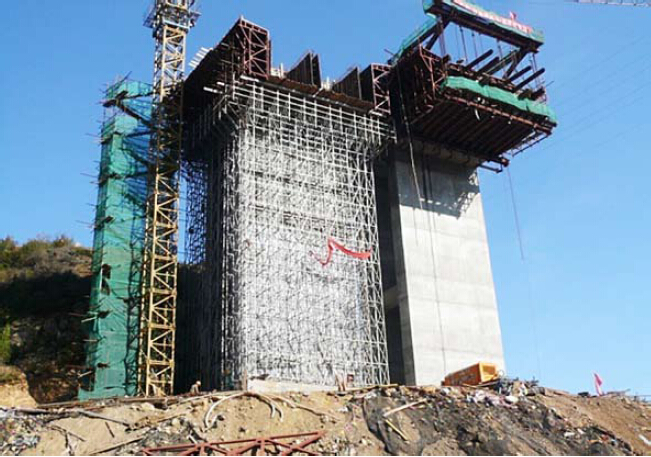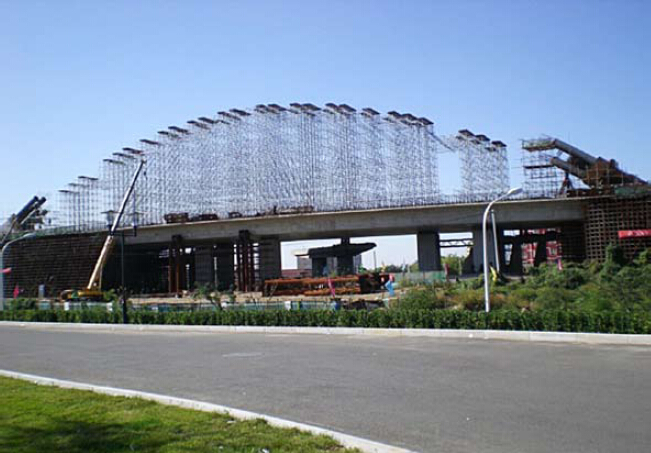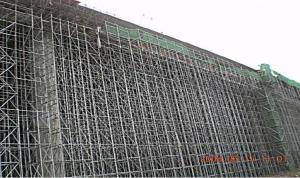Tower Scaffolding for formwork and scaffolding system
- Loading Port:
- Tianjin
- Payment Terms:
- TT OR LC
- Min Order Qty:
- 50 m²
- Supply Capability:
- 1000 m²/month
OKorder Service Pledge
Quality Product, Order Online Tracking, Timely Delivery
OKorder Financial Service
Credit Rating, Credit Services, Credit Purchasing
You Might Also Like
Tower Scaffolding
Shoring tower is an effective supporting system. It is easy to assemble and dismantlement, and
has excellent stability and bearing capacity. It has been widely used in the construction of industry
& residential buildings , bridges, tunnels and dam project, etc.
Characteristics:
◆ High degree of standardization.
◆ Easy storage and transportation


- Q:How does steel formwork contribute to the sustainability of a construction project?
- Steel formwork contributes to the sustainability of a construction project in several ways. Firstly, steel formwork is highly durable and has a long lifespan. This means that it can be used for multiple construction projects, reducing the need for new formwork and minimizing waste. Additionally, the durability of steel formwork reduces the need for frequent repairs or replacements, saving both time and resources. Secondly, steel formwork is a reusable material. It can be easily disassembled and reassembled for use in different projects, reducing the demand for new formwork and minimizing the amount of waste generated. This significantly reduces the environmental impact of construction projects, as it reduces the need for new materials and decreases the amount of waste sent to landfills. Furthermore, steel formwork is highly efficient and allows for faster construction times. Its strength and stability enable the construction process to progress more quickly, reducing the overall duration of the project. This not only saves time but also reduces the energy consumption associated with construction activities, contributing to the overall sustainability of the project. Moreover, steel formwork is a recyclable material. At the end of its lifespan, the steel formwork can be recycled, further reducing its environmental impact. Recycling steel requires less energy and resources compared to manufacturing new steel, thus reducing greenhouse gas emissions and conserving natural resources. In summary, steel formwork contributes to the sustainability of a construction project by being durable, reusable, efficient, and recyclable. It reduces the need for new formwork, minimizes waste generation, saves construction time, and conserves resources. By incorporating steel formwork into construction projects, builders can significantly reduce the environmental impact while ensuring long-term durability and efficiency.
- Q:What are the different types of steel formwork accessories available?
- In the market, one can find a variety of steel formwork accessories that serve different purposes. These accessories are specifically designed to improve the efficiency and effectiveness of steel formwork systems, thereby making the construction process smoother. Here are some commonly used types of steel formwork accessories: 1. Formwork clamps: These clamps are utilized to securely connect formwork panels, guaranteeing stability and preventing any movement while pouring concrete. They come in various sizes and shapes to fit different formwork systems. 2. Formwork ties: These ties are employed to hold formwork panels together and provide additional support. Formwork ties are available in different lengths and materials to meet various formwork requirements. 3. Formwork connectors: These connectors are used to join formwork panels at corners or intersections. They create a strong and secure connection, ensuring proper alignment and stability of the formwork system. 4. Formwork wedges: These wedges are used to adjust the inclination or angle of formwork panels. They are typically made of steel and can be easily inserted or removed to achieve the desired formwork configuration. 5. Formwork brackets: These brackets are utilized to vertically or horizontally support formwork panels. They are adjustable and can be easily installed or removed to accommodate different formwork configurations. 6. Formwork spacers: These spacers are used to maintain a specific spacing between formwork panels. They ensure consistent concrete thickness and prevent bulging or deformation during the pouring process. 7. Formwork props: These props are used to support the formwork system and provide additional stability. They can be adjusted in height and easily installed or removed as required. 8. Formwork anchors: These anchors are employed to secure the formwork system to the ground or existing structure. They provide stability and prevent any movement during the concrete pouring and curing process. Overall, these steel formwork accessories are crucial for ensuring the structural integrity and stability of the formwork system. They are designed to withstand high pressure and offer a reliable and efficient solution for construction projects.
- Q:How does steel formwork handle concrete surface blemishes?
- Steel formwork is known for its durability and strength, which helps in handling concrete surface blemishes effectively. Due to its rigid structure, steel formwork provides a smooth and even surface for pouring and shaping concrete. This minimizes the occurrence of blemishes such as air pockets, cracks, or unevenness. Additionally, steel formwork offers better control over the pouring and curing process, reducing the chances of surface imperfections. Overall, steel formwork ensures a high-quality finish and helps to minimize concrete surface blemishes.
- Q:What is the weight of steel formwork?
- The weight of steel formwork can vary depending on several factors such as the dimensions and thickness of the steel panels, the type and arrangement of supports, and any additional reinforcements or attachments. Generally, steel formwork panels can range from around 20 to 40 kilograms per square meter. However, it is important to note that these figures are approximate and may differ based on the specific design and specifications of the steel formwork being used.
- Q:Can steel formwork be used for sports complex construction projects?
- Yes, steel formwork can be used for sports complex construction projects. Steel formwork is a versatile and durable option for creating temporary molds or structures for casting concrete. Its strength and flexibility make it suitable for various construction projects, including sports complexes. Steel formwork can provide the necessary support and stability required during the construction process, ensuring the efficient and accurate placement of concrete in complex shapes and designs.
- Q:What are the typical dimensions of steel formwork panels?
- Steel formwork panels can have varying dimensions depending on the specific project requirements and the manufacturer. However, standard sizes for these panels typically range from 1.2 meters (4 feet) to 3.6 meters (12 feet) in length, and from 0.3 meters (1 foot) to 1.2 meters (4 feet) in width. The thickness of the panels can also vary, usually falling between 6mm (0.24 inches) and 25mm (1 inch). These dimensions are carefully chosen to provide flexibility and adaptability to different construction needs, while ensuring that the panels are sufficiently strong to withstand the pressures and forces exerted during concrete pouring and curing processes.
- Q:Can steel formwork be used in high-rise construction?
- Yes, steel formwork can be used in high-rise construction. Steel formwork offers several advantages that make it suitable for high-rise construction projects. Firstly, steel formwork is strong and durable, capable of withstanding the high pressure of concrete placement in tall structures. It provides stability and rigidity, ensuring the formwork remains intact during the construction process. Additionally, steel formwork is versatile and can be easily customized to meet the specific requirements of high-rise buildings. It can be easily adjusted and reconfigured to accommodate various shapes and sizes, allowing for flexible and efficient construction. Steel formwork also provides a smooth and high-quality finish to concrete surfaces, which is crucial for high-rise buildings that require aesthetic appeal. Moreover, steel formwork is reusable, reducing the overall cost of construction. Unlike traditional timber formwork, steel formwork can be dismantled and reused multiple times, making it a cost-effective solution for high-rise projects. This also reduces waste and promotes sustainability in construction. Lastly, steel formwork offers enhanced safety during high-rise construction. Its strength and stability minimize the risk of accidents and collapses, creating a safer working environment for construction workers. In conclusion, steel formwork can indeed be used in high-rise construction due to its strength, versatility, cost-effectiveness, and safety features. It is a reliable and efficient solution that meets the unique requirements of tall structures.
- Q:Can steel formwork be used for both precast and cast-in-place concrete elements?
- Yes, steel formwork can be used for both precast and cast-in-place concrete elements. Steel formwork is a versatile and durable option that can be reused multiple times, making it suitable for both precast and cast-in-place applications. For precast concrete elements, steel formwork can be fabricated to the desired shape and size, allowing for consistent and accurate production of the elements in a controlled environment. On the other hand, for cast-in-place concrete elements, steel formwork can be easily assembled and disassembled on-site, providing the necessary support and containment for the fresh concrete until it sets and gains strength. Overall, steel formwork is a flexible solution that can be utilized for various concrete construction methods, including both precast and cast-in-place applications.
- Q:What are the features of the new building template?
- Now more and more domestic building template market demand, the new building template can get greater economic benefits. The new building template
- Q:How does steel formwork contribute to sustainable construction practices?
- Steel formwork contributes to sustainable construction practices in several ways. Firstly, steel is a highly durable material that can be reused multiple times, reducing the need for frequent replacement and minimizing waste. This longevity also reduces the demand for raw materials, decreasing the environmental impact associated with their extraction and manufacturing. Additionally, steel formwork allows for efficient and precise construction, resulting in less material wastage and reducing the overall carbon footprint of the project. Furthermore, steel is recyclable, making it easy to recover and reuse at the end of its life cycle, further reducing environmental impact. Overall, the use of steel formwork promotes sustainability by minimizing waste, conserving resources, and reducing the environmental footprint of construction projects.
1. Manufacturer Overview |
|
|---|---|
| Location | |
| Year Established | |
| Annual Output Value | |
| Main Markets | |
| Company Certifications | |
2. Manufacturer Certificates |
|
|---|---|
| a) Certification Name | |
| Range | |
| Reference | |
| Validity Period | |
3. Manufacturer Capability |
|
|---|---|
| a)Trade Capacity | |
| Nearest Port | |
| Export Percentage | |
| No.of Employees in Trade Department | |
| Language Spoken: | |
| b)Factory Information | |
| Factory Size: | |
| No. of Production Lines | |
| Contract Manufacturing | |
| Product Price Range | |
Send your message to us
Tower Scaffolding for formwork and scaffolding system
- Loading Port:
- Tianjin
- Payment Terms:
- TT OR LC
- Min Order Qty:
- 50 m²
- Supply Capability:
- 1000 m²/month
OKorder Service Pledge
Quality Product, Order Online Tracking, Timely Delivery
OKorder Financial Service
Credit Rating, Credit Services, Credit Purchasing
Similar products
New products
Hot products
Hot Searches
Related keywords























